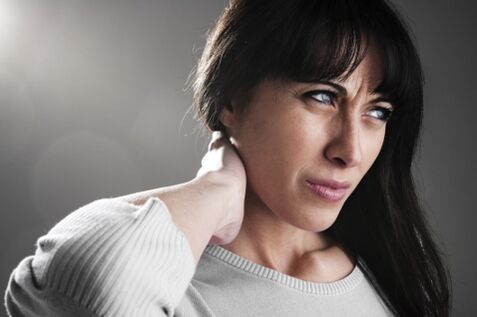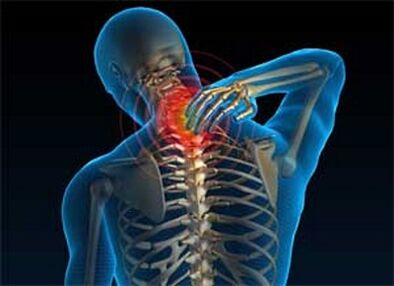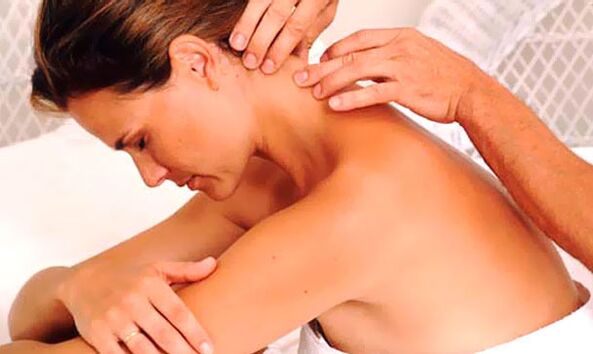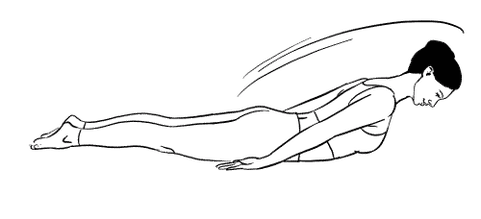
It is very sad to recognize, but at the moment almost everyone who has reached the 25th anniversary suffers from osteochondrosis of the cervical vertebra.This disease is most common in the cervical vertebrae compared to other spine departments.So this topic is very relevant in the modern world.
We will tell you why osteochondrosis appears, how it manifests itself and how to treat them.
Let us also think about which medication works more effectively and we give an example of the necessary exercises to treat this disease.
Osteochondrosis of the cervical spine is a degenerative process in the intervertebral discs, which significantly reduces its height in the cervical spine.It not only leads to changes in intervertebral discs, but also in the vertebrae and joints of this department.
The causes of osteochondose of the cervix region
The factors are listed directly at the bottom because the input increases the pressure on the cervical spine.To compensate for this, the neck muscles try to move the excess load, and as a result there is a cramp and circulatory disorders in this area that contain degenerative changes.
The causes of cervical osteochondrosis in men and women (factors that influence the development of osteochondrosis of the cervical spine):
- Violation of the attitude or curvature of the spine;
- Obesity;
- Hypodynamics is a sitting lifestyle (for example, sitting with a driver, office worker).
- Trauma or damage to the spine;
- Point in the metabolism:
- Regular physical activity;
- Stress or unstable psychoemotional condition;
- The physical condition of the muscles is not sufficiently developed.
- It was inherited from the parents;
- Constant the phone with a shoulder;
- The development of anomalies in the cervical spine.

The causes of osteochondose of the cervical spine are only worsened without timely medical intervention.
The development of the cervix osteochondrosis
The degree of osteochondrosis is not its stage at all.It is determined based on the words of the patient and the general clinical image.We will get to know each other a little later.
So:
The first degree
Minimal manifestations, the patient complains about a weak pain of the cervix region, which intensifies when they turn their heads.During the examination it can be determined that the neck muscles are slightly tense.
The second degree
The pain in the cervical spine becomes much more intense.It can spread to the shoulders and arms.This is explained by the fact that the height of the intervertebral disc reduces and the roots of the nerves are violated.Pain grows when a person leans or turns his head.The patient is concerned about headaches, constant weakness and even a reduction in performance.
The third degree
Explicit symptoms of osteochondrosis manifest themselves and are regularly present.The frequent pain in the arm or shoulder can cause the nobility of the upper extremity and the weakening of the muscles due to the formation of intermediate vertical hernia.Constant weakness and dizziness.During the examination it can be shown that the cervical spine becomes less mobile and painful during the feeling of this website.
The fourth degree
The intervertebral disc is completely destroyed, which now replaces the connective tissue.Dizziness intensified, noise occurs in the ears, the coordination is disturbed because the vertebral artery to the cerebellum and the occipital of the brain is affected.
The worsening of the neck osteochondrosis is extremely dangerous due to the small size of this department and the great importance for the entire bone apparatus of the body.The slightest shift of vertebrates can lead to compression of the most important nerve endings.And educated osteophytes at a later point in time, even the worst consequences for blood vessels and nerves will lead.A negative result can be a hernia or a lead of the spine, which is why the nervous spine swells and then ignites.As complications of cervical osteochondrosis, this is compression of the spinal cord.The defeat extends not only on the neck and head, but also to the limbs (initially at the upper).
What are the symptoms of cervical osteochondrosis?
Osteochondrosis of the cervical spine differs a lot in its symptoms of such a disease in other parts of the spine.This can be explained by the fact that in this part of the spine a very small distance between the vertebrae, which means that with the slightest pathology the nerve endings and the spinal cord are immediately caught.

The most common symptoms of osteochondrosis of the neck and thoracic spine:
- Pain.It can be localized both in the neck and on the back of the head, in the shoulder or even in hand.The pain in the occipital part of the head is caused by muscle cramps that are attached to the occipital bones from the neck and cause disorders in blood circulation.Pain sensations in the shoulder or in the upper extremity are due to the attraction of nerve endings that supply the muscles of these body parts.
- Weakness in the hands.It is the result of damage to the nerve responsible for the movement, the inner -four muscles of the hand.
- Reduction of the sensitivity of the hand.It appears when the process harms the nerve, which delivers sensitivity in the skin of the upper extremity.
- The movement in the cervical spine in the cervical spine is limited, the crunch when moving the neck.It is explained by the fact that the height of the intervertebral disc is reduced, bone growth on the body of the vertebrae and small joints in the intervertebral disc.
The symptoms of the neck -osteochondrosis orders that occur in the brain are expressed by weakness, dizziness and an impairment of the coordination.These symptoms occur when the vertebral artery is involved in the process, which leads through its own channel in the holes of the cross processes of the cervical vertebrae.Due to the development of cervical osteochondrosis, fiber tissue shapes are displaced.The blood circulation in the arteries deteriorates, which leads to a deterioration in blood supply to the arrival area of the brain and cerebellum.
- Taub of language, hearing loss and vision.Symptoms of an advanced form of cervical osteochondrosis when the blood circulation in the occipital part of the brain, cerebellar and fuselage worsens.
A lump in the throat with osteochondrosis of the cervical spine is very common and not very specific.Many people take it for a cold symptom and fight it with warmth, rinsing and medication.However, these are not these methods of fight, so there is no relief.Most of the time, strengthening the symptoms occurs at night, and the patients crawl in the fear that they cannot be inhaled in the next part of the air.
The main symptoms of a neck osteochondrosis are pain, weakness in the hands, the restriction of movements in the cervical region, dizziness, impairment of the coordination and deafness of the tongue.
Such symptoms of cervical osteochondrosis in women and men should not be ignored.If you occur, you must visit neurology immediately.
Grabs of cervical osteochondrosis
The main methods of diagnostics:
- X -Ray of the cervical spine.Not a particularly informative path, especially in the advanced stage of osteochondrosis.
- Computer tomography.It shows shifts in the vertebrae, but it is difficult to set the presence and size of the intervertebral disc hernia and to determine the pressure of the hernia on the spinal cord.
- Magnetic resonance imaging.The most informative way.You can not only display the bone structure, but also the intervertebral discs, the presence of a hernia, its size and growth direction.
- Duplex scanning of blood vessels.It is used if there is a suspicion that a bloodstream is disrupted in the vertebrae arteries.With this method, it is sufficient to easily determine the changes in the speed of the blood circulation and to quickly identify obstacles in its way.
X -Ray stages of cervical osteochondrosis:
Level I - Minor changes in the arrangement of the vertebrae, the cervix lordosis of the spine is smoothed;
II Stadium - Instability between the vertebrae appears, one spine against another can change, Thoros is not excluded - the rotation of the vertebrae around the axis, the height of the intervertebral disc is slightly reduced;
Stage III - A general decrease in the height between the intervertebral discs is ¼.
Stage IV - The height of the intervertebral disc is significantly reduced.The osteoarthritis of the intervertebral disc joints, very large osteophytes, actively develop, the bandes and spine canal, with the development of myelopathy.
Treatment of cervical osteochondrosis

The main methods for the treatment of cervical osteochondrosis are treatment with medication, physiotherapy, massage of the cervix muscles and a very effective therapeutic gymnastics.
Below you will find the groups of medicines used in the treatment of osteochondrosis of the cervical spine:
- Non -steroid anti -inflammatory medication helps to get ready with pain, to alleviate the aseptic inflammation of the joints and the edema of the damaged nerve root;
- B -Vitamine - metabolism in nerve tissues;
- Medicines that normalize the rheological properties of blood and blood circulation;
- Chondroprotectors - medication that restore cartilage tissue in a damaged intervertebral disc;
- Musorelaxants are medication that eliminate muscle cramp.
Attention!The medication listed is presented for convening and never start too medically!
The main methods for the treatment of cervical osteochondrosis are treatment with medication, physiotherapy, massage of the cervix muscles and a very effective therapeutic gymnastics.
Physiotherapy
The auxiliary treatment of the osteochondrosis of the cervical spine cannot be shown without physiotherapeutic methods.
Medical electrophoresis - Under the influence of electrical current, medical substances penetrate the necessary part of the body.
Ultrasound - guarantees the removal of inflammation and pain relief and accelerates the metabolic processes in the treatment zone.
Magnetotherapy - relieves the tissue edema, which anesthetes the effect of the exposure.
Laser therapy - With the help of the light flow, inflammation is removed and the blood circulation is normalized.
Medical physical education

Physical physical education is not a means that can be healed osteochondrosis alone.This technique is only used in the recreation stage after the end of drug treatment or physiotherapy.When executing exercises, a person should not feel uncomfortable or pain.
Exercise number 1
In a lying position on the stomach that can be rested with both hands on the floor, raising your head and upper body, your back is straight all the time.Linger for 2 minutes in this position.We'll look down slowly, repeat 2-3 times.
Exercise number 2
In the position of lying on the stomach, stretch your hands along the body, turn your head to the left, touch the floor with your ear, as well as to the right, repeat this 6-7 times on each side.
Exercise number 3
Seat position.In inspiration - a slope forwards to touch the chest with his head.When exhaling lean back and throw his head back, repeat it 10 times.
Exercise number 4
In a seated position.Place your palms on your forehead, put pressure on it and press your forehead into your palm.The duration of the exercise is 30 seconds, repeated 2-3 times.
Exercise number 5
Slow circular movements of the head, first to the right, to the left.10 rotations for each direction.If dizziness occurs, you should stop the exercise immediately.
Physical physical lessons are only used in the recreation stage after the drug treatment or physiotherapy has ended.It is important that a person should not feel any symptoms or pain when performing exercises.





















